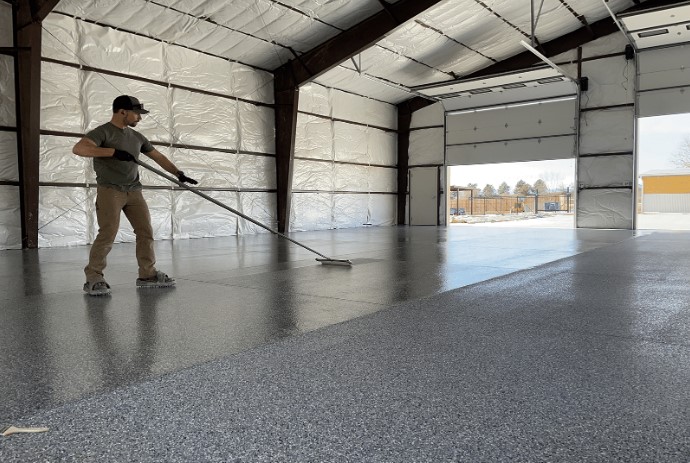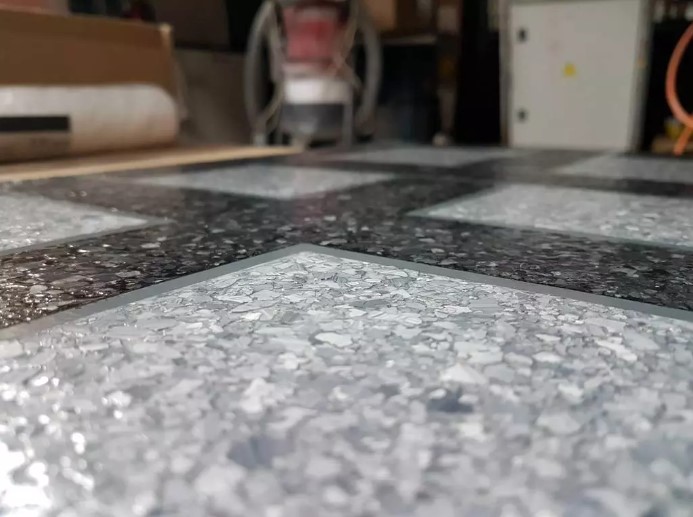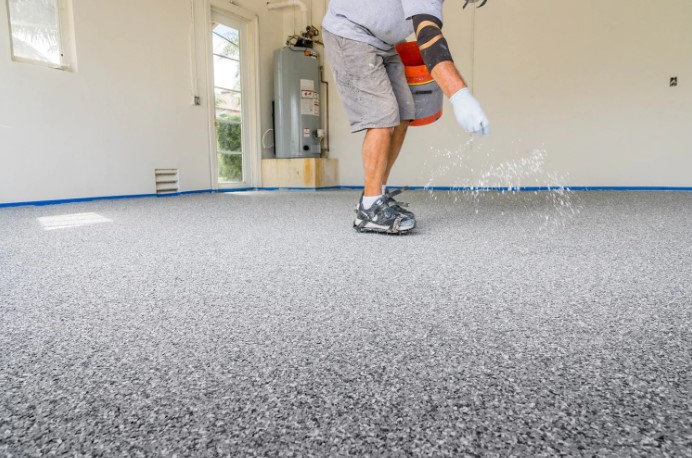
When we install a new polyaspartic floor, a primary concern for us and our homeowners is determining when it’s safe to use the floor. This concern is particularly significant in New Jersey, where the weather can be unpredictable. Polyaspartic flake floors are favored for their quick installation time and robust durability, making them a top choice among New Jersey homeowners. To ensure longevity and maintain the floor’s pristine condition, knowing the optimal time to walk on your new polyaspartic flake floor is crucial.
The ideal time to walk on a new polyaspartic flake floor is after the curing process, which typically takes about 4-6 hours for light foot traffic. For full usage, including moving heavy furniture or allowing vehicles on the surface, it’s recommended to wait at least 24 hours.
What is a Polyaspartic Flake Floor?
A polyaspartic flake floor is a type of decorative and protective coating that is commonly used in residential and commercial spaces. It is made up of multiple layers of epoxy resin, colored flakes, and a clear topcoat. Polyaspartic flake floors are known for their high durability, resistance to chemicals and UV rays, and quick installation time. They are also available in a variety of colors, patterns, and textures, making them a popular choice for homeowners looking to enhance the aesthetic appeal of their floors.
Also known as chip or flake floors, polyaspartic flake floors are created by broadcasting decorative vinyl flakes into a wet epoxy basecoat. The topcoat is then applied to seal the flakes and create a smooth, glossy finish. This process results in a durable, seamless floor that can withstand heavy foot traffic and other forms of wear and tear.
Polyaspartic flake floors are also highly customizable, allowing homeowners to choose from a wide range of flake sizes and colors to create a unique design. They are commonly used in high-traffic areas such as garages, basements, and commercial spaces due to their durability and low maintenance requirements.
Factors that Affect the Curing Time
There are several factors that can affect the curing time of a polyaspartic flake floor, including:
Temperature And Humidity
Temperature and humidity are two of the most crucial factors that affect the curing time of a polyaspartic flake floor. In New Jersey, where weather conditions can be unpredictable, it is essential to consider these factors carefully. Generally, polyaspartic floors cure faster in warmer temperatures and lower humidity levels.
If the temperature is too low or the humidity is too high, the curing process can be slowed down. This can result in a weaker and less durable floor, as well as potential issues with adhesion and bonding between layers.
Additionally, extreme temperature fluctuations can also affect the curing time and overall durability of a polyaspartic flake floor. It is crucial to maintain consistent temperatures and humidity levels throughout the installation and curing process to ensure maximum durability.
Number Of Layers Applied
The number of layers applied to a polyaspartic flake floor can also impact its curing time. Typically, the more layers that are applied, the longer it will take for the floor to cure completely. This is because each layer needs time to dry and cure before another layer can be added.
It is essential to follow the manufacturer’s recommendations for the number of layers to be applied to achieve optimal results. Adding too many or too few layers can affect the overall durability and appearance of the floor.
Plus, adding too many layers can also increase the risk of air bubbles forming between layers, which can weaken the floor’s structure and cause it to fail prematurely.
Thickness Of Each Layer
The thickness of each layer also plays a significant role in the curing time of a polyaspartic flake floor. Thicker layers will take longer to dry and cure compared to thinner layers. It is crucial to follow the manufacturer’s guidelines for the recommended thickness of each layer to ensure proper curing and maximum durability.
Applying an inadequate amount of material in each layer can result in a weaker and less durable floor, while applying too much material can cause issues with adhesion and bonding between layers.
Additionally, thicker layers may also require longer curing times to ensure that the floor is fully dried and cured before use. It is essential to be patient and not rush the process to achieve the best results for your polyaspartic flake floor.
Type And Quality Of Materials Used
The type and quality of materials used also have a significant impact on the curing time and overall durability of a polyaspartic flake floor. Using low-quality materials or mixing them improperly can result in longer curing times, weaker floors, and potential issues with adhesion and bonding between layers.
It is crucial to use high-quality materials specifically designed for polyaspartic flake flooring to ensure the best results. This includes using the recommended epoxy basecoat, colored flakes, and clear topcoat.
Additionally, following the manufacturer’s instructions for mixing and applying each layer is essential to achieve optimal curing and maximum durability.
Airflow and ventilation in the space
Proper airflow and ventilation are crucial for the curing process of a polyaspartic flake floor. It is recommended to have adequate ventilation in the space during installation and curing to ensure that fumes from the materials do not accumulate.
Additionally, proper airflow can help speed up the drying and curing process by allowing moisture to escape more efficiently. This can result in a stronger and more durable floor.
It is also essential to avoid excessive air movement or drafts in the space, as they can cause uneven drying and curing, resulting in a weaker floor. Maintaining consistent airflow and ventilation throughout the installation and curing process is essential for achieving optimal results with a polyaspartic flake floor.
Average Curing Time for Polyaspartic Flake Floors

The average curing time for a polyaspartic flake floor can vary depending on the factors mentioned above. Generally, polyaspartic floors take approximately 24 hours to cure completely. However, this can be affected by the temperature, humidity, and number of layers applied.
In ideal conditions, with temperatures between 70-80 degrees Fahrenheit and humidity levels below 50%, a polyaspartic flake floor can cure in as little as 6-8 hours.
In colder or more humid conditions, the curing time can be extended to 24 hours or more. It is essential to monitor these factors closely during the installation and curing process to ensure that the floor is given enough time to cure properly.
It is also important to note that while the floor may be dry to the touch after 24 hours, it can take up to 7 days for a polyaspartic flake floor to reach its full strength and durability.
Why Proper Curing Matters
Proper curing is crucial for the longevity and durability of a polyaspartic flake floor. Rushing or cutting corners during the installation and curing process can result in a weaker and less durable floor that is prone to cracking, chipping, and delamination.
Taking the time to properly cure the floor ensures that all layers are fully dried and bonded together, creating a strong and durable surface. It also allows for any air bubbles or imperfections to be addressed before the floor is put into use.
Proper curing also helps the floor resist stains, chemicals, and other forms of wear and tear that it may encounter in its lifetime. A well-cured polyaspartic flake floor can last for many years with minimal maintenance and repairs.
Also, proper curing can help achieve the desired appearance of the floor. Rushing the process or not following recommended guidelines for layers and thickness can result in an uneven and less aesthetically-pleasing surface.
How much weight can a cured polyaspartic flake floor withstand?
A properly cured polyaspartic flake floor is highly durable and can withstand significant weight without damage. It is suitable for use in high-traffic areas, commercial spaces, and even industrial settings.
The weight capacity of a cured polyaspartic flake floor may vary depending on the thickness and number of layers applied, but it can typically hold up to 4,000-5,000 pounds per square inch. This means that it can easily support heavy machinery and equipment without cracking or breaking.
Additionally, polyaspartic flake floors are resistant to impacts and abrasions, making them suitable for use in areas with heavy foot traffic or vehicles. They can also withstand exposure to harsh chemicals and extreme temperatures, further increasing their weight-bearing capacity.
However, it is essential to follow recommended guidelines for layer thickness and curing time to ensure the maximum strength and durability of a polyaspartic flake floor. Cutting corners or not allowing enough time for proper curing can weaken the floor’s ability to withstand weight and other forms of wear and tear.
Mistakes to Avoid when Curing a Polyaspartic Flake Floor
Proper curing is crucial for the success and durability of a polyaspartic flake floor. Here are some common mistakes to avoid during the installation and curing process:
- Rushing the process: As mentioned, proper curing takes time, and rushing through it can result in a weaker and less durable floor. Also, Properly cured polyaspartic floors can last for decades with minimal maintenance and repairs.
- Not following manufacturer’s instructions: Each layer of a polyaspartic flake floor requires specific steps to be followed for proper mixing and application. Not following these instructions can result in issues such as air bubbles, weak adhesion between layers, and an uneven appearance.
- Applying layers too thick or thin: Applying layers of epoxy basecoat, colored flakes, and clear topcoat in the recommended thickness is essential for achieving a strong and visually appealing floor. Applying them too thick or thin can result in an uneven surface and decrease the floor’s durability.
- Inadequate ventilation: As mentioned earlier, proper airflow and ventilation are crucial during the curing process. Not having adequate ventilation can result in fumes from the materials accumulating, slowing down the drying and curing process, and potentially affecting the floor’s quality.
- Not allowing enough curing time: It can be tempting to use the floor as soon as it feels dry, but it is crucial to allow enough time for the layers to fully cure and bond together. Not allowing enough curing time can result in a weaker and less durable floor that may require repairs or replacement in the future.
By avoiding these mistakes and following recommended guidelines for installation and curing, you can ensure that your polyaspartic flake floor is strong, durable, and aesthetically pleasing for years to come.
Does curing affect the maintenance of a polyaspartic flake floor?
Proper curing plays a significant role in the long-term maintenance of a polyaspartic flake floor. As mentioned, rushing or not following recommended guidelines for curing can result in a weaker and less durable floor that may require more frequent maintenance and repairs.
A well-cured polyaspartic flake floor is resistant to stains, chemicals, and other forms of wear and tear. This means that it requires minimal maintenance efforts, such as regular sweeping and mopping.
Additionally, a properly cured polyaspartic flake floor can withstand heavy foot traffic and the weight of furniture and equipment without showing signs of damage. This reduces the need for repairs or replacements, resulting in long-term cost savings.
Furthermore, the smooth and seamless surface of a cured polyaspartic flake floor makes it easy to clean and maintain. Unlike other flooring materials that may have grout lines or seams where dirt and bacteria can accumulate, a polyaspartic flake floor can be easily wiped down and sanitized.
Also, curing helps to seal and strengthen the surface of a polyaspartic flake floor, making it more resistant to scratches and abrasions. This means that the floor’s appearance can be maintained for longer without needing costly resurfacing or refinishing.
Tips for maintaining a polyaspartic flake floor

Here are some tips to help you maintain the longevity and beauty of your polyaspartic flake floor:
- Regular cleaning: Sweeping or vacuuming regularly can prevent dirt, debris, and other particles from scratching the floor’s surface. Mopping with a gentle cleaner can also help to keep the floor looking shiny and new.
- Avoid harsh chemicals: While polyaspartic flake floors are highly resistant to chemicals, it is still best to avoid using harsh cleaning agents that can damage the surface. Stick to mild cleaners specifically designed for use on epoxy floors.
- Use protective mats: Placing doormats or rugs at entryways can help prevent dirt and debris from being tracked onto the floor. Additionally, using protective mats under furniture or equipment legs can prevent scratches and damage.
- Address spills immediately: Promptly clean up any spills on your polyaspartic flake floor to avoid staining or potential damage to the surface.
- Avoid dragging heavy objects: When moving furniture or equipment, lift instead of dragging to prevent scratches or damages to the floor.
By following these tips and regularly maintaining your polyaspartic flake floor, you can ensure that it remains strong, durable, and visually appealing for many years. So if you are considering installing a new flooring system, consider the benefits of a properly cured polyaspartic flake floor.
FAQs
Is it possible to over-cure a polyaspartic flake floor?
Yes, it is possible to over-cure a polyaspartic flake floor by leaving the layers to cure for too long. This can result in a brittle and weak surface that is more prone to cracking and chipping. Also, it is essential to follow manufacturer’s instructions and recommended curing times to avoid over-curing.
Can a polyaspartic flake floor be repaired if damaged?
Yes, one advantage of polyaspartic flake floors is that they can be easily repaired. Depending on the severity of the damage, repairs may involve sanding down the surface and reapplying a new topcoat or patching and filling in any cracks or chips. It is best to consult a professional for repairs to ensure they are done correctly.
How long does it take for a polyaspartic flake floor to cure?
The curing time for a polyaspartic flake floor can vary depending on factors such as temperature, humidity, and ventilation. However, in general, it takes around 24-48 hours for a polyaspartic flake floor to cure fully.
Is there any special maintenance required after installation and curing?
No, once the floor is properly installed and cured, regular sweeping and mopping with gentle cleaners should suffice for maintenance. It is also recommended to avoid using harsh chemicals or dragging heavy objects on the surface to prevent damage. regular maintenance of your polyaspartic flake floor will ensure its longevity and durability.
Polyaspartic flake floors are durable, beautiful and easy to maintain
Proper installation and curing are crucial for ensuring the strength and longevity of these floors. By avoiding common mistakes such as improper surface preparation or not allowing enough curing time, you can enjoy a beautiful and resilient polyaspartic flake floor for years to come.
Remember to also follow recommended maintenance tips to keep your floor looking its best and avoid costly repairs or replacements. With these factors in mind, a polyaspartic flake floor can be an excellent investment for any residential or commercial space. So if you are considering a new flooring system, consider the benefits of a properly installed and cured polyaspartic flake floor.
